- Home
- Hunter S. Thompson
Fear and Loathing in Las Vegas Page 2
Fear and Loathing in Las Vegas Read online
Page 2
The letters published in Fear and Loathing in America—the second volume in a projected trilogy—cover the eight frenetic years from 1968 to 1976 when Thompson was at the glorious height of his literary powers. As documented in the first collection, The Proud Highway: Saga of a Desperate Southern Gentleman, the Kentucky-bred Thompson had slowly risen in the world of journalism, writing for such newspapers and journals as The New York Herald Tribune, The National Observer, The Nation, The Reporter, and The New York Times Magazine. While working continually on two novels—“Prince Jellyfish” (unpublished), set in New York City, and The Rum Diary (1998), based in Puerto Rico—Thompson garnered a formidable reputation in newsrooms for his reportage on the bizarre. In his freelance journalism he wrote profiles of Butte hobos, Caribbean smugglers, Beat poets, nude dancers, Sacramento politicians, Oregon drifters, flower children, riverboat gamblers, bluegrass pickers, San Joaquin migrant workers, and Sioux activists. As critic Richard Elman noted in The New Republic, Thompson was asserting a “kind of Rimbaud delirium of spirit” in his writing, which “only the rarest of geniuses” could pull off. Such well-known American chroniclers as Studs Terkel, Tom Wolfe, William Kennedy, and Charles Kuralt were the first reporters to recognize that Thompson was a masterful prose stylist, imbued with a strange gift for comic despair and sledgehammer humor. They saw him as a hilarious schemer, an attack dog like H. L. Mencken, an outrageous outsider like novelist J. D. Salinger’s Holden Caulfield. Meanwhile, mainstream editors also learned to respect Thompson’s well-honed instinct for accurately reporting on the fringe characters of the tumultuous 1960s. “He became our official crazy,” John Leonard claimed in The New York Times, “patrolling the edge.” Now, with the wild success of Hell’s Angels, the first printing selling out within days of publication, Thompson had the freedom to explore “the edge” in new modes of journalism that borrowed from fiction writing.
Almost overnight, assignment offers came pouring in from Esquire, Harper’s, The Saturday Evening Post, and a dozen other periodicals, all anxious for an offbeat piece from the celebrated thirty-year-old author of Hell’s Angels. It soon became apparent, however, that Thompson’s fiercely subjective style just wasn’t for editors with weak stomachs or nervous advertisers. Playboy, for example, had assigned Thompson to write a profile of Jean-Claude Killy, a handsome Olympic skier turned Chevrolet pitchman. “On balance, it seems unfair to dismiss him as a witless greedhead, despite all the evidence,” Thompson concluded. “Somewhere behind that wistful programmed smile I suspect there is something akin to what Norman Mailer once called (speaking of James Jones) ‘an animal sense of who has the power.’” This was too unhinged for Playboy, too honest. In rejecting what literary historians now deem the first pure example of Gonzo journalism—the piece eventually ran as “The Temptations of Jean-Claude Killy” in the March 1970 Scanlan’s Monthly—Playboy’s editor composed an internal memo denouncing “Thompson’s ugly, stupid arrogance” as “an insult to everything we stand for.”
What becomes clear in Fear and Loathing in America is how important a role the editor of Scanlan’s Monthly, Warren Hinckle, played in the development of Thompson’s infamous Gonzo style. The two first met in San Francisco in 1967 when Hinckle was running the leftist magazine Ramparts. As a pure literary art form, Gonzo requires virtually no rewriting: the reporter and his quest for information are central to the story, told via a fusion of bedrock reality and stark fantasy in a way that is meant to amuse both the author and the reader. Stream-of-consciousness, article excerpts, transcribed interviews, telephone conversations—these are the elements of a piece of aggressively subjective Gonzo journalism. “It is a style of reporting based on William Faulkner’s idea that the best fiction is far more true than any kind of journalism,” Thompson has noted. Today the term “Gonzo” appears in the Webster’s and Random House dictionaries—with Thompson given credit as its coiner—but when Hinckle first published the Killy piece in Scanlan’s, he was taking a huge risk. His editorial gamble would soon pay off handsomely, however, when Thompson returned to his hometown of Louisville—with British illustrator Ralph Steadman at his side—to cover America’s premier Thoroughbred horse race.
The story of how Thompson and Steadman first teamed up to take on the Kentucky Derby is revealed for the first time through the letters in this collection. One evening in May 1970, Hunter and his wife, Sandy, were dining at the Aspen home of James Salter, a dear friend whose novel A Sport and a Pastime is considered a modern classic. Salter, knowing that Thompson was raised along the Ohio River, casually asked him if he was going to attend the Derby. “I told him ‘no,’” Thompson remembered. “But I immediately seized upon the idea that I should cover it.” At 3:30 the next morning, Thompson telephoned Hinckle and got the assignment. Refusing a photographer, Thompson suggested that editorial cartoonist Pat Oliphant from The Denver Post accompany him to the mint-julep spectacle. Oliphant was unavailable, so Hinckle hired the thirty-four-year-old Steadman, a Welsh illustrator renowned for his hideous and hilarious caricatures of British politicians in Private Eye magazine. The combustible pairing changed the face of modern journalism: they produced “The Kentucky Derby Is Decadent and Depraved,” in which Thompson’s traditional reportage was skewed in favor of a viciously funny, first-person, Gonzo perspective while Steadman’s perversely exact illustrations were drawn in lipstick to shock the unprepared reader. The outrageous, ribald result won immediate acclaim. “The Derby story had pointed the way toward the great mother lode,” novelist and friend William Kennedy recalled. “Hunter had discovered that confounding sums of money could be had by writing what seemed to be journalism, while actually you were developing your fictional oeuvre.”
But as we learn at the outset of Fear and Loathing in America, it was the 1968 presidential election that jarred Thompson to unleash his vitriolic prose on the leading politicians of the day. It all began with his first weird encounter with Richard Nixon, the Republican nominee, whom he interviewed that February in New Hampshire. Thompson had considered Nixon “just another sad old geek limping back into politics for another beating.” But the new Nixon—full of football stories and the “V” for victory sign—startled him. “He was brighter and therefore more dangerous than I had surmised,” Thompson recalled. “He was a brute in need of extermination.”
That July, Pageant published Thompson’s “Presenting: The Richard Nixon Doll.” The piece marked the beginning of Thompson’s relentless stalking of Nixon, his all-purpose arch-nemesis. This book, in fact, could easily have been subtitled The Age of Nixon. Two of Thompson’s most enduring works—the incomparable Fear and Loathing: On the Campaign Trail ’72, published by Straight Arrow Books in 1973, and the cogent “Fear and Loathing at the Watergate: Mr. Nixon Has Cashed His Check,” a lengthy article that appeared in the September 27, 1973, Rolling Stone—were inspired by Thompson’s insatiable distrust of Richard Nixon. When the president resigned under the dark cloud of Watergate, Thompson’s first instinct was to throw a sack of dead rats over the wrought iron White House fence in celebration. Thompson acknowledged his debt to “Tricky Dick” by dedicating his 1979 anthology, The Great Shark Hunt, “To Richard Milhous Nixon, who never let me down.” And his merciless obituary of Nixon, published in 1994 in Rolling Stone, stands as the most devastating critique of a politician since H. L. Mencken set out to destroy the populist reputation of Nebraska’s William Jennings Bryan shortly after the 1925 Scopes “monkey” trial.
Yet perhaps even more than the dark specter of Nixon, it was the brutish actions of the Chicago police force at the Democratic National Convention in 1968 that gave Thompson the fear. Somewhat foolishly, Thompson had signed a contract with Random House to write a nonfiction book on “The Death of the American Dream.” He had journeyed from his ranch in Woody Creek, Colorado, which remains his home, to the Windy City in hopes of gathering material for the book. While waiting with other members of the press to get into the convention hall, he witnessed a mob of demonstrators marchi
ng toward a flank of policemen at the corner of Michigan and Balboa. Seconds later, the police charged the protestors with billy clubs waving. Ignoring the press credentials that hung around his neck, the police shoved Thompson against a plate glass window as chaos and violence erupted all around him. “I went to the Democratic Convention as a journalist,” Thompson wrote of the encounter, “and returned a cold-blooded revolutionary.”
Chicago proved to be the political awakening of Hunter S. Thompson. No longer would he simply write about politics, he would personally enter the fray. Believing that “politics was the art of controlling your environment,” Thompson soon found himself in the unlikely role of leader of the Freak Power Movement in the Rocky Mountains. Many of the letters published here center on Thompson’s hubristic run for sheriff of Pitkin County, Colorado, in 1970. “The die is already cast in my race,” he wrote. “And the only remaining question is how many freaks, heads, criminals, anarchists, beatniks, poachers, Wobblies, bikers and persons of weird persuasion will come out of their holes and vote for me.” With his head shaved clean, a bright-red fist with two thumbs clasping a peyote button as his campaign poster, jazz artist Herbie Mann’s spirited “Battle Hymn of the Republic” as his anthem, and a party platform that included changing Aspen’s name to “Fat City” to slow down development, Thompson’s savage campaign attracted considerable national attention.
Other celebrated American writers have run for political office—Upton Sinclair in California and Norman Mailer in New York, for example—but none with the surreal flair with which Thompson conducted his 1970 campaign for sheriff. The New York Times assessed him favorably in a profile featuring a photograph of Thompson in front of a large portrait of FBI Director J. Edgar Hoover, while Harper’s commissioned a lengthy essay on his dark horse run. “In the ominous, ugly-splintered context of what is happening in 1970 Amerika a lot of people are beginning to understand that to be a freak is an honorable way to go,” Thompson wrote on one of the eight Wallposters he produced for the campaign. “This is the real point: that we are not really freaks at all—not in the literal sense—but the twisted realities of the world we are trying to live in have somehow combined to make us feel like freaks. We argue, we protest, we petition—but nothing changes.
“So now, with the rest of the nation erupting in a firestorm of bombings and political killings, a handful of ‘freaks’ are running a final, perhaps atavistic experiment with the idea of forcing change by voting.” Astonishingly, Thompson lost by only four hundred–odd votes of more than twenty-five hundred cast. In fact, he carried three of the four city precincts, but was massively rejected by voters in the populous down-county suburbs and ski centers.
More than any other periodical it was Rolling Stone, a rock ’n’ roll magazine published in San Francisco, that embraced Thompson’s wildcat run for sheriff. Brazen owner and editor Jann Wenner had become a principal spokesman for the so-called “Love Generation,” and his magazine—its name taken from the title of a Muddy Waters blues song—was setting the tone for counterculture art and fashion in America. The first piece Thompson wrote for Rolling Stone, published in the October 1, 1970, issue, was “The Battle of Aspen,” an autobiographical account of the Freak Power Movement in Colorado. Like Hinckle, whose Scanlan’s Monthly soon folded because of financial mismanagement, Wenner understood that Thompson was a rock ’n’ roll mix of Ernest Hemingway, F. Scott Fitzgerald, and H. L. Mencken—a sort of literary wild man running amok on speed and insolence, yet with a controlled grace and unreal precision to his hallucinatory prose, and in the end his trenchant and sober-minded critiques of modern society were perhaps, as Nelson Algren put it, “the sanest of all.” By 1970, what Bob Dylan had become to electric music, Hunter Thompson had become to cutting-edge journalism.
Sidetracked by Aspen politics and freelance assignments, Thompson, as revealed in this volume, was having a hard time with his book on “The Death of the American Dream” for Random House. Deadlines came and went. Debts piled up and frustration grew. Stone broke was a way of life. It was under this intense duress that—while working on a serious investigative piece for Rolling Stone on Ruben Salazar, a Chicano activist who had been shot and killed by a member of the Los Angeles County Sheriff’s Department—Thompson stumbled on the answer to his three-year-old quest in the glitzy gambling emporiums of Nevada.
The appearance of Fear and Loathing in Las Vegas in two issues of Rolling Stone in 1971, under the pseudonym Raoul Duke, sealed Thompson’s reputation as an outlaw genius. As the subtitle warns, the work takes readers on “a savage journey to the heart of the American Dream.” The New York Times review said, “What goes on in these pages makes Lenny Bruce seem angelic. … The whole book boils down to a kind of mad, corrosive poetry.” Tom Wolfe pronounced it “a scorching, epochal sensation.” Essentially, the narrative follows Duke and his three-hundred-pound Samoan attorney, Dr. Gonzo, to Las Vegas, ostensibly to cover a motorcycle race and then a convention of district attorneys. How did Thompson and his accomplice prepare for the trip? As Duke wrote: “We had two bags of grass, seventy-five pellets of mescaline, five sheets of high-powered blotter acid, a salt shaker half full of cocaine, and a whole galaxy of multi-colored uppers, downers, screamers, laughers … and also a quart of tequila, a quart of rum, a case of Budweiser, a pint of raw ether and two dozen amyls.”
The primary question that readers of Fear and Loathing in Las Vegas ask is: Was it all true? Did he really gobble up all those drugs? Was his attorney—a thinly disguised portrayal of Chicano activist Oscar Zeta Acosta—really that demented? The correspondence included in this volume between Thompson and his Random House editor, Jim Silberman, addresses this speculation in a frank, candid, and surprising fashion. An unexpected image emerges of Thompson as clever wordsmith, completely coherent and purposeful as he tries to puncture the hypocrisy of Rotarian America and fulfill his contractual obligation to boot. Self-editing throughout the process of completing the book at Owl Farm in Colorado and a Ramada Inn in California, Thompson knew he had a bizarre classic on his hands, a book that only he could have written.
Also included in Fear and Loathing in America are several of the outlandish letters that Acosta, the legendary Brown Buffalo, wrote to Thompson from California and Mexico during the 1970s. A nearly full-blooded Aztec Indian obsessed with the violent legacy of Cortés the Killer in the New World, Acosta is now considered one of the most influential “Chicano Power” playwrights, defense attorneys, and intractable activists of his era. Raised by Mexican parents in El Paso, Texas, as a strict Catholic, Acosta received formal religious training in Panama. Blessed and afflicted with a hyperkinetic disposition and forever craving the limelight, Acosta loved to preach like an Old Testament prophet one minute, then eat LSD like a deranged drug offender on the run the next. But one historical observation from the period is certain: a synergy developed between Thompson and Acosta during the winter of 1967–1968 that benefited both artists. “There were times—all too often, I felt—when Oscar would show up in front of the courthouse at nine in the morning with a stench of fresh gasoline on his hands and a green crust of charred soap-flakes on the toes of his $300 snakeskin cowboy boots,” Thompson wrote in his memorable Rolling Stone obituary of Acosta, who died mysteriously in 1977 somewhere in Mexico. “He would pause outside the courtroom just long enough to give the TV press five minutes of crazed rhetoric for the Evening News, then he would shepherd his equally crazed ‘clients’ into the courtroom for their daily war-circus with the Judge. When you get into bear baiting on that level, paranoia is just another word for ignorance. … They really are out to get you.”
Paranoia is a central theme on nearly every page of this book. Deep suspicions of the FBI, the CIA, and the Secret Service abound. Doom is always looming down; financial ruin is always on the horizon like a thundercloud about to break. In Thompson’s distrustful world, agents are thieves, editors are swine, and politicians, with occasional exceptions like former South Dakota senator George McGov
ern, are charlatans. While writing the series of articles for Rolling Stone that became Fear and Loathing: On the Campaign Trail ’72, Thompson excoriated George Wallace, Hubert Humphrey, Edmund Muskie, Henry “Scoop” Jackson, Richard Nixon—the whole phalanx of candidates. But unlike other sharp-tongued critics of the American political process, there was a Jeffersonian idealism in Thompson’s writing that transcended mere cynicism. “Hunter was a patriot,” McGovern recalls of the Gonzo journalist who crisscrossed the nation with him in 1972. “He thought in universal terms. He was not a jingoist. He hated that war in Vietnam with a passion. And he hated the hypocrisy of the establishment. Basically, I think he wanted to see this country live up to his ideals. And he wanted us to do better. There is no doubt that what he wrote in 1972 was the most valuable book on the campaign.”
Fear and Loathing in America holds many surprises for the political junkie. We learn of Thompson’s wild-eyed ambition to run for the U.S. Senate from Colorado, his retention of lawyer Sandy Berger to sue cartoonist Garry Trudeau for the potentially libelous portrayal of him as “Uncle Duke” in the Doonesbury comic strip, his strange friendship with Nixon man Patrick Buchanan, and his unexpected embrace of Jimmy Carter during the 1976 presidential election. There are feuds with journalists Sidney Zion and Sally Quinn, denunciations of Timothy Leary and Abbie Hoffman, and bitter disappointment when even McGovern turned to the pols. Experimentation—and overindulgence—in drugs such as mescaline, hashish, and LSD are also commonplace occurrences in these letters. For a while, in fact, Thompson considered titling this book “Confessions of a Mescaline Eater” or “The Jimson Weed Chronicles,” in tribute to narcotics enthusiasts Thomas DeQuincey and William S. Burroughs.

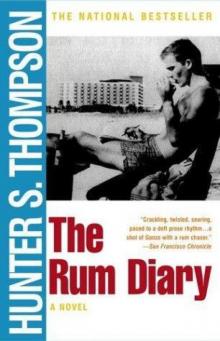 The Rum Diary
The Rum Diary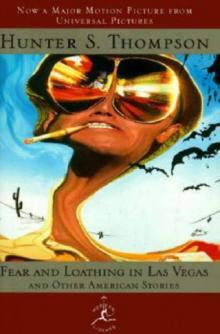 Fear and Loathing in Las Vegas and Other American Stories
Fear and Loathing in Las Vegas and Other American Stories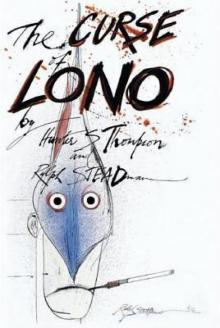 The Curse of Lono
The Curse of Lono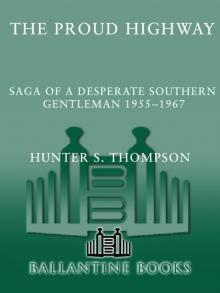 Proud Highway: Saga of a Desperate Southern Gentleman, 1955-1967
Proud Highway: Saga of a Desperate Southern Gentleman, 1955-1967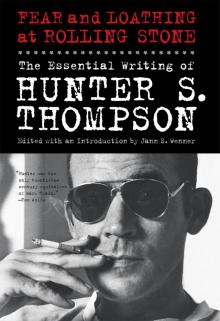 Fear and Loathing at Rolling Stone: The Essential Hunter S. Thompson
Fear and Loathing at Rolling Stone: The Essential Hunter S. Thompson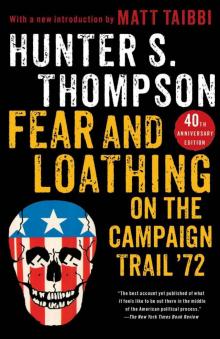 Fear and Loathing on the Campaign Trail '72
Fear and Loathing on the Campaign Trail '72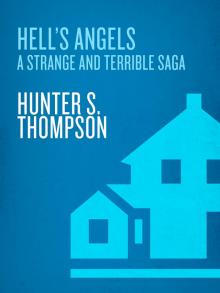 Hell's Angels: A Strange and Terrible Saga
Hell's Angels: A Strange and Terrible Saga The Great Shark Hunt: Strange Tales From a Strange Time
The Great Shark Hunt: Strange Tales From a Strange Time Fear and Loathing in America
Fear and Loathing in America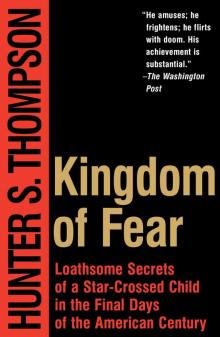 Kingdom of Fear
Kingdom of Fear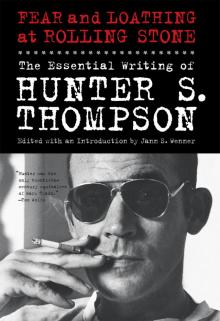 Fear and Loathing at Rolling Stone
Fear and Loathing at Rolling Stone Hell's Angels
Hell's Angels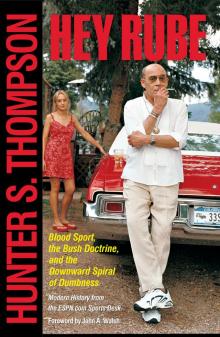 Hey Rube
Hey Rube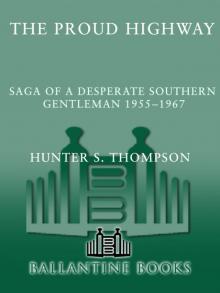 Proud Highway
Proud Highway